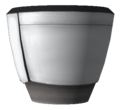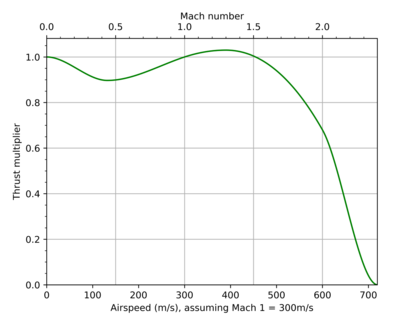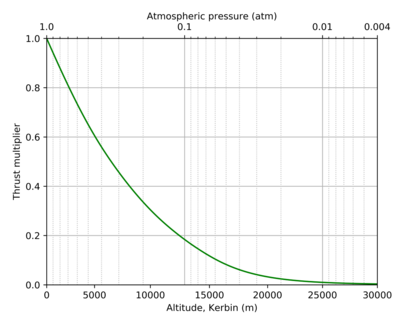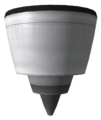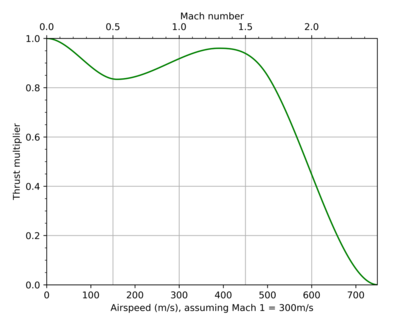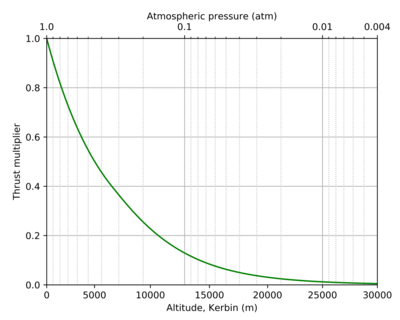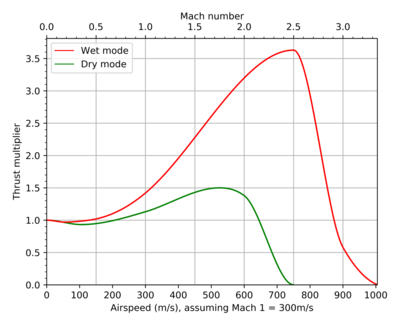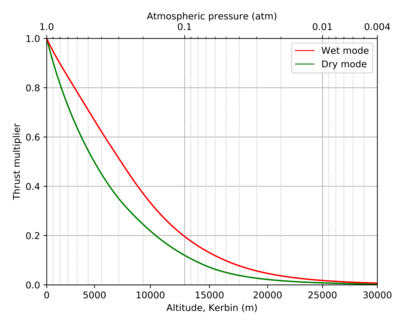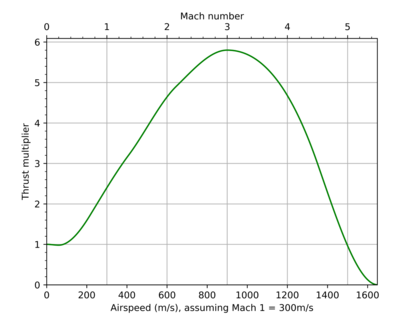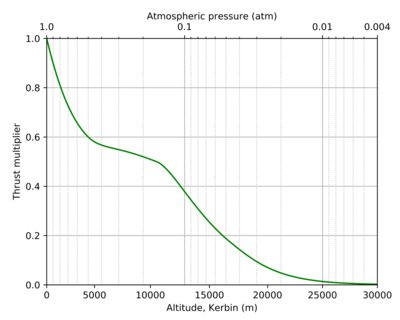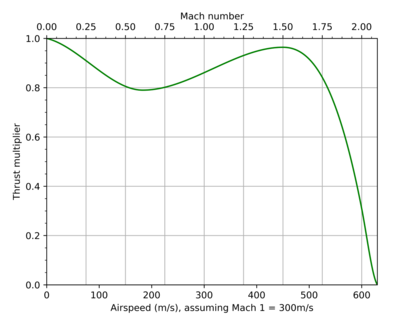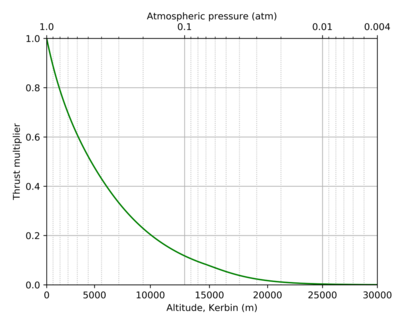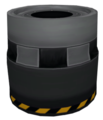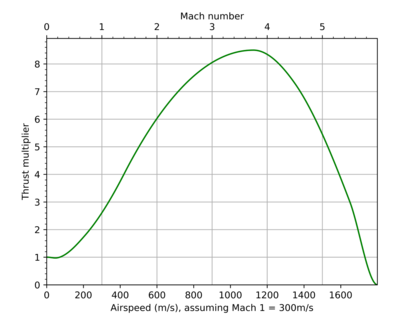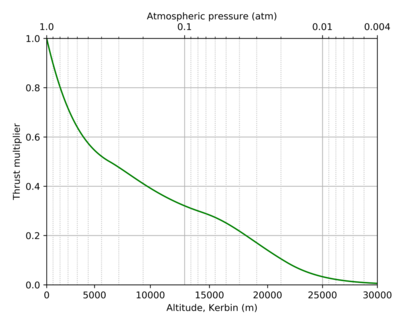Difference between revisions of "J-90 "Goliath" Turbofan Engine"
m (Removed statement regarding engines rotating the same direction causing roll. This is incorrect.) |
Lone Starr (talk | contribs) (Intro text expanded, Performance and usage sort of created, based on J-33 Wheesley, Stub box removed, RL counterpart moved to trivia) |
||
| Line 1: | Line 1: | ||
| − | + | The '''J-90 "Goliath" Turbofan Engine''' is a large [[Jet engine|air-breathing engine]] which uses [[liquid fuel]] and [[intake air]], added with version 1.0.5 of Kerbal Space Program. This engine is the fourth air-breathing engine which can be unlocked in the [[Technology tree|tech tree]], after the [[J-404 "Panther" Afterburning Turbofan]], although in another branch of the tree. It is the only jet engine with large [[radial size]], and built in [[air intake]]. This airliner engine pretty much can be considered the advanced big brother of the [[J-33 "Wheesley" Turbofan Engine]], having practically identical performance curves, thrust reverse and even higher fuel efficiency. | |
| − | |||
| − | |||
| − | == Usage == | + | == Performance and Usage == |
| − | + | ||
| + | Unlike many of the other jet engines (and all of the rockets), this engine is capable of reversing its thrust, which makes it useful for rapid deceleration during landing and for backing into hangars. Since aircraft are usually built with more than one of this engine, it can also be handy for making sharp turns on the ground, since one engine can be put into reverse while the other continues pushing forwards. However, reversing on one side should be avoided in flight, as severe changes in lift on certain areas of the airframe will occur, possibly leaving the flight unrecoverable. Therfore thrust reverse should be assigned to an action group on multi-engine designs to ensure symmetric thrust / brakin force. The only other engine capable of this feat is its little brother, the 'Wheesley'. | ||
| + | |||
| + | As with all jet engines, its thrust decreases significantly with altitude. Its maximum '''stationary''' thrust is rated at 360 kN at sea level. At about 8,000 m it generates just 132 kN, and at about 15,000 m it generates no more than 37 kN, ceasing to work entirely at about 20,900 m, which is somewhat below the 'Wheesley'. Note that the behavior between these points (as shown in the part stats) is slightly non-linear. | ||
| + | |||
| + | Thrust output also varies with '''speed''', although far less than on the high-speed engines. Contrary to theese, its thrust does not increase with speed, similar to the other two low-speed engines. Up to Mach 0.5 the thrust drops to about 80%, recovering to 95% from Mach 1.3 to 1.7. Going faster, the thrust drops considerably quick, limiting usage to about Mach 2.1. | ||
| + | |||
| + | The [[Specific_impulse|I<sub>sp</sub>]] stays constant over the full range of application, which is a big change compared to KSP in pre-1.0 versions. It is rated at 12,600 s, making it the most fuel-efficient engine. As the engine is much bigger compared to the 'Wheesley' and as such generates considerably more drag at higher speeds, the surplus in I<sub>sp</sub>] likely is lost beyond mach ~1.3, dependent on plane design. | ||
| + | |||
| + | Overall, it works best between 8,000 and 15,000 m altitude on a larger (MK3 ..) cargo plane. Flying lower, the high air resistance requires more thrust which lowers the fuel efficiency, while in higher areas the engine's thrust output is simply too low for reasonable performance in flight. Placing it on a small plane, the size and weight of the engine likely eats up the nominal advantage over the 'Wheesley' | ||
| + | |||
| + | Note that currently, the only planets which this engine will work on are [[Kerbin]] and [[Jool]]'s moon [[Laythe]]. | ||
| + | |||
{| style="float: left;" | {| style="float: left;" | ||
| Line 15: | Line 25: | ||
== Product description == | == Product description == | ||
{{Quote|The largest and highest thrust jet engine ever built. This engine works best at low cruising speeds and altitudes.|manufacturer=C7}} | {{Quote|The largest and highest thrust jet engine ever built. This engine works best at low cruising speeds and altitudes.|manufacturer=C7}} | ||
| + | |||
==Trivia== | ==Trivia== | ||
*The J-90 is the only jet engine shown with moving fan/turbocompressor. | *The J-90 is the only jet engine shown with moving fan/turbocompressor. | ||
| − | *Although this engine can run at Mach | + | *Although this engine can run at Mach 2 with no problems, real-life turbofans can not go past Mach 0.89 usually due to the fact that this puts excessive stress on the mechanical components of the engine and would lead to inevitable engine disintegration. Low-bypass turbofans can go past Mach 1.0 but they quickly lose efficiency as the airspeed increases. |
| − | + | *It is based on the [[w:Rolls-Royce Trent 800|Rolls-Royce Trent 800]] and the [[w:General Electric GE90|GE90]] high bypass turbofan engines. | |
== Changes == | == Changes == | ||
;[[1.0.5]] | ;[[1.0.5]] | ||
Revision as of 13:07, 11 March 2017
The J-90 "Goliath" Turbofan Engine is a large air-breathing engine which uses liquid fuel and intake air, added with version 1.0.5 of Kerbal Space Program. This engine is the fourth air-breathing engine which can be unlocked in the tech tree, after the J-404 "Panther" Afterburning Turbofan, although in another branch of the tree. It is the only jet engine with large radial size, and built in air intake. This airliner engine pretty much can be considered the advanced big brother of the J-33 "Wheesley" Turbofan Engine, having practically identical performance curves, thrust reverse and even higher fuel efficiency.
Performance and Usage
Unlike many of the other jet engines (and all of the rockets), this engine is capable of reversing its thrust, which makes it useful for rapid deceleration during landing and for backing into hangars. Since aircraft are usually built with more than one of this engine, it can also be handy for making sharp turns on the ground, since one engine can be put into reverse while the other continues pushing forwards. However, reversing on one side should be avoided in flight, as severe changes in lift on certain areas of the airframe will occur, possibly leaving the flight unrecoverable. Therfore thrust reverse should be assigned to an action group on multi-engine designs to ensure symmetric thrust / brakin force. The only other engine capable of this feat is its little brother, the 'Wheesley'.
As with all jet engines, its thrust decreases significantly with altitude. Its maximum stationary thrust is rated at 360 kN at sea level. At about 8,000 m it generates just 132 kN, and at about 15,000 m it generates no more than 37 kN, ceasing to work entirely at about 20,900 m, which is somewhat below the 'Wheesley'. Note that the behavior between these points (as shown in the part stats) is slightly non-linear.
Thrust output also varies with speed, although far less than on the high-speed engines. Contrary to theese, its thrust does not increase with speed, similar to the other two low-speed engines. Up to Mach 0.5 the thrust drops to about 80%, recovering to 95% from Mach 1.3 to 1.7. Going faster, the thrust drops considerably quick, limiting usage to about Mach 2.1.
The Isp stays constant over the full range of application, which is a big change compared to KSP in pre-1.0 versions. It is rated at 12,600 s, making it the most fuel-efficient engine. As the engine is much bigger compared to the 'Wheesley' and as such generates considerably more drag at higher speeds, the surplus in Isp] likely is lost beyond mach ~1.3, dependent on plane design.
Overall, it works best between 8,000 and 15,000 m altitude on a larger (MK3 ..) cargo plane. Flying lower, the high air resistance requires more thrust which lowers the fuel efficiency, while in higher areas the engine's thrust output is simply too low for reasonable performance in flight. Placing it on a small plane, the size and weight of the engine likely eats up the nominal advantage over the 'Wheesley'
Note that currently, the only planets which this engine will work on are Kerbin and Jool's moon Laythe.
Product description
| “ | The largest and highest thrust jet engine ever built. This engine works best at low cruising speeds and altitudes. — C7 Aerospace Division |
” |
Trivia
- The J-90 is the only jet engine shown with moving fan/turbocompressor.
- Although this engine can run at Mach 2 with no problems, real-life turbofans can not go past Mach 0.89 usually due to the fact that this puts excessive stress on the mechanical components of the engine and would lead to inevitable engine disintegration. Low-bypass turbofans can go past Mach 1.0 but they quickly lose efficiency as the airspeed increases.
- It is based on the Rolls-Royce Trent 800 and the GE90 high bypass turbofan engines.
Changes
- Initial release
| Part | Velocity curve(s) | Atmosphere curve(s) |
|---|---|---|
|
|
||
|
|
||
|
|
||
|
|
||
|
|
||
|
|


